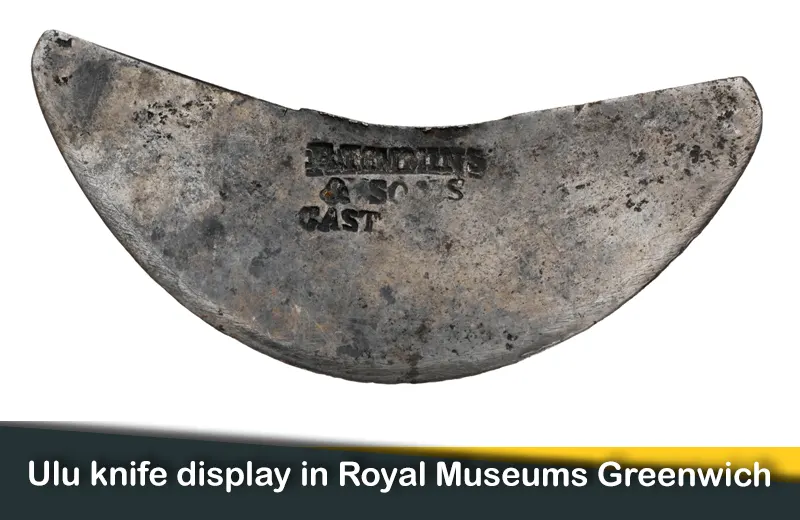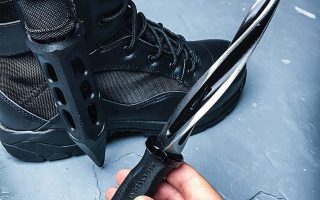Have you ever seen an Ulu knife? It’s a cutting tool used by Inuit. Mostly known by rocker knife these days, have a rich history in Alaska. This extremely old knife design dates back centuries- 5000 years or more.
In this article, we will dive into the origin of Ulu knives, what it was used for and is it still around present days! So read on
What is a ULU knife?
An Ulu is an Inuit cutting implement. Traditionally it’s kind of a woman’s knife. It has been used for lots of things and they have been around for thousands of years. It is used typically above the arctic circle- a lot of places in Greenland, Alaska, and other tribes.
This extremely old knife design dates back centuries. It’s been used all around the world. Its heritage came from those places. Back then this was a go-to knife for everything. It was literally an all-purpose knife they used this cut each other’s hair, to shave ice blocks and making igloos, to skin animals, to separate the blubber, and all kinds of stuff.
And Ulu knives were passed down from generation to generation. It was believed the spirit of their ancestors was in the knife and it was something they needed to survive. That’s a very rich history for a knife.
Lately, Ulu knives have discovered their way back to present-day kitchens. They are very easy to utilize, flexible, and don’t need a lot of work to slice through hard materials. This knife is indispensable in the kitchen. It’s great for cutting up all kinds of things.
This knife stood the test of time cause of its thoughtful design. The ergonomic design of the knife allows you to perform literally any task. The handle of the knife is designed in such a unique way that it puts accurate pressure directly on the blade. Nw the ulu knife comes with a blade made of high-quality stainless steel with a sharp edge, comfortable handle, more contemporary design with laser etchings.
Uses:
The uses of an ulu knife are boundless. Chopping, dicing, skinning and cleaning animals, shaving hair to trimming hair, any sorts of kitchen task, you name it and you can do it well with this knife.
History of the ULU Knife
Dating back to 2500BC Uluaq was invented as a cutting tool especially for Inuit women. The knives were made from slate blades. And for the handle, they used ivory, hard bone, or wood. With time they started making the ulu blade with copper and iron instead of slate for a better edge. Now, these knives are made of high-quality stainless steel.
Indigenous people would use this knife to cut the hard bone from meat, to skin animals and skin fish, to separate the blubber all of these things were easier to do with an Ulu knife.
The Eskimo people used to shave ice blocks to make igloos with these knives. They also used to worship the knives as they believe the soul of their ancestor lived in them. These knives used to be passed from generation to generation and that’s why they took great pride in these knives.
Types of ULU Knives
1. Iñupiat or Alaskan ULU Knife
This is the legendary knife of the arctic. This genuine Alaskan ulu knife ensures fine cuts and chopping. It’s made in Alaska. The knife features a 6-inch long stainless steel blade and a wooden handle. The handle gives a very comfortable grip. The steel has great edge retention and corrosion resistance. So it’s perfect for any kitchen task with ease. You feel the desired control when you are handling the knife while chopping and slicing. This Alaskan ulu knife comes with a walnut stand.
2. Canadian ULU Knife
The Canadian ulu knife has a very interesting design. This signature design features a thin stem as a connection between the handle and the blade. This knife comes in two models. The more regular triangular shape blade is utilized in the western part of Canada and the pointed one was found mostly in the eastern part of the Canadian arctic.
3. West Greenlandic
This knife features an elliptical blade that is joined to the handle with a thin stem. The handle is compact and small unlike the Canadian ulu knife and the blade is oval-shaped.
4. East Greenlandic
This Ulu knife is similar to, the West Greenlandic Ulu knife. They have the same design. The blade and the handle are connected by a thin stem. But this knife highlights a large rectangular-shaped blade. The handle is curved and compact.
Size:
Normally, the size of an ulu blade will in general influence its utility and utilization. At the end of the day, the size mirrors the use of an ulu blade. For example, an ulu blade whose sharp edge is little, for example, only 2 inches long, is great for slicing ligament that connects muscle to bone.
Centuries back, a specific little ulu blade is known as the Kimagtuut, was utilized to make designs from the skin of creatures like seals and caribous. Essentially, for general errands, a 6-inch model was viewed as great. Indeed, even today, this size is considered as the standard one for most models. However, it is normal to discover models of around 12 inches.
In present days, the best ulu blade is maybe the one that can perform any type of kitchen tasks and other basic tasks.
Build Material
The blade of an ulu knife was usually built from jade, polished slate, copper, ivory, and wood or bone for the handle.
But modern Ulu knives are made using stainless steel. And the handle of the Alaskan model is made of caribou antler. You can also find some model that comes in a pair with a cutting board and plastic handle.
All are strong materials. Nonetheless, in case you are against animal cruelty, stay away from caribou antler or bone as the form material.
Maintenance
An ulu blade is very simple to keep up with. Infrequent sharpening is crucial for ensuring that the edge is cutting fine. With regards to sharpening, perform it utilizing a steel or hard stone on the slanted side.
Conclusion
Thinking about purchasing an Ulu blade? I say, do it! You can look at the Ulu Factory Alaskan Ulu Knife. It’ll surely give you a brief look at antiquated occasions, and give a perfect cutting tool for culinary tasks.
The Ulu blade figured out how to get by for over 5000 years, since the Eskimos created it, to our day and age. It’s an adaptable cutting tool that saves energy and conquers through hard materials without breaking a sweat.

Hi, my name is Taras Kulakov and I’m a knife enthusiast. I have been collecting knives for over 30 years and I’ve owned literally thousands of different models over that time. My goal with this site is to share some of what I’ve learned about knives. You can find more info about Taras Kulakov here.



![What Are The Top American Made Knives? [Best Knife Makers] 4 What Are The Top American Made Knives](https://knivesngear.com/wp-content/uploads/2022/11/What-Are-The-Top-American-Made-Knives-320x200.jpg)

